Lithuania
Basic Data
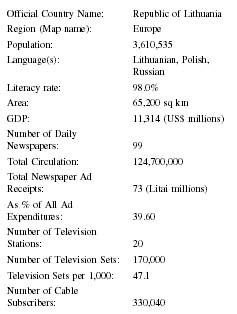
| Official Country Name: | Republic of Lithuania |
| Region (Map name): | Europe |
| Population: | 3,610,535 |
| Language(s): | Lithuanian, Polish, Russian |
| Literacy rate: | 98.0% |
| Area: | 65,200 sq km |
| GDP: | 11,314 (US$ millions) |
| Number of Daily Newspapers: | 99 |
| Total Circulation: | 124,700,000 |
| Total Newspaper Ad Receipts: | 73 (Litai millions) |
| As % of All Ad Expenditures: | 39.60 |
| Number of Television Stations: | 20 |
| Number of Television Sets: | 170,000 |
| Television Sets per 1,000: | 47.1 |
| Number of Cable Subscribers: | 330,040 |
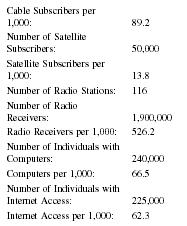
| Cable Subscribers per 1,000: | 89.2 |
| Number of Satellite Subscribers: | 50,000 |
| Satellite Subscribers per 1,000: | 13.8 |
| Number of Radio Stations: | 116 |
| Number of Radio Receivers: | 1,900,000 |
| Radio Receivers per 1,000: | 526.2 |
| Number of Individuals with Computers: | 240,000 |
| Computers per 1,000: | 66.5 |
| Number of Individuals with Internet Access: | 225,000 |
| Internet Access per 1,000: | 62.3 |
Background & General Characteristics
Historical Traditions
Lithuania, the largest of the Baltic nations, has experienced and been influenced by numerous foreign occupations. The name Lithuania was first mentioned in the Latin chronicle Annales Quedlin burgenses in AD 1009, and it was thought that the Lithuanian peoples were descendants of ancient Roman settlers. However, it is more likely that the original people came from Asia about 4,000 to 10,000 years ago. Lithuania's development as a nation was not linear: it has existed as an independent state only intermittently throughout its history of invasions and occupations. However, even when the national language, Lithuanian, was banned and reading or writing books in the native tongue was forbidden, the people were determined to preserve their heritage and traditions for future generations. This strong attachment to their culture remains a characteristic of Lithuanians in the twenty-first century.
Lithuania adopted Christianity at the end of the fourteenth century and has remained predominantly Roman Catholic. During the Soviet domination and ban on religion, Catholicism was never totally suppressed. It was ready for a revival when independence was achieved. Religion always played a significant role in Lithuanian publications and the initial books to be published in Lithuanian were religious ones. The first book, Catechism , was written by Mazvydas and published in 1547 in the town of Karaliaucius. The first publishing house was founded in Vilnius.
In the fourteenth century, Lithuania and Poland formed a confederation that lasted almost two hundred years and became one of medieval Europe's largest empires. In the eighteenth century Lithuania came under Russian rule and Russia attempted unsuccessfully to eradicate the Lithuanian culture and language. The religious emphasis of the publications changed, and secular literature became more widespread. By the early twentieth century, most writing was linked to the independence movement.
The occupation of Lithuania by imperial Russia lasted until 1915, and from 1864 to 1904, the Russian alphabet was introduced, and the press in Latin was banned. Nonetheless, the people of Lithuania protected their identity and rights and successfully rallied against the larger country of Russia. The ban on the press was lifted in 1904. In 1905, the Vilnius Seimas (legislative body) urged the people to stop paying taxes and to refuse to send their children to Russian schools. After World War I, on February 16, 1918, the country proclaimed its independence; it adopted its first permanent constitution on August 1, 1922. The second permanent constitution was adopted on May 12, 1938.
Lithuania was an independent nation between World War I and II and maintained its religious affiliation to Catholicism. From this religious group emerged a cadre of progressive individuals who played an important role in the intellectual life of the country, including the press. However, in 1940 Lithuania was once again annexed to the USSR and the Soviets undermined the creativity of the writers. With the arrival of the occupying Soviet troops, the intellectuals were arrested, or if they were able, they migrated to the West. Those who remained continued to write in secret. On July 21, 1940, the national Seimas proclaimed the country a Soviet Socialist Republic, and on August 3, 1940, Lithuania became the fourteenth member of the Soviet Union. This event minimized the country's ties to the West and the influence of its media, thus essentially leaving Lithuania in a news vacuum.
The Soviet regime decimated the entire economy of the country; all financial establishments were nationalized. Local culture became sovietized. The only respite came at the end of 1941 when the Soviets became more involved in their war with Germany and withdrew their troops. With the withdrawal of the Communists, there was a resurgence of hope for freedom, and the Lithuanians strove to regain their independence by proclaiming a provisional government. However, the Germans did not recognize this administration and it was abolished. Nonetheless, major resistance newspapers were published, the anti-Nazi movement flourished, and consequently the Germans failed to organize a local SS legion.
On July 13, 1944, the Soviets re-entered Vilnius, and the entire country was once again under Soviet domination. Although Lithuania attempted to resist the occupation, the Soviets destroyed the economy, and the rights that had been established by the Republic of Lithuania were eroded. Any signs of independence and national identity were extinguished. For the next 40 years Lithuania was subjugated to the political, economical, and cultural goals of the Soviet Union, including press censorship. This strict control continued until the 1980s when the Soviet policy changed and people were given more freedom to speak out against the government without fear of reprisals. By the end of the 1980s, economic chaos in the Soviet Union forced the Soviet president, Mikhail Gorbachev, to institute reforms: glasnost was declared. Also during this period, Lithuania established many democratic changes, and the press became more and more independent. In 1988 the Lithuanian Communist Party (LCP) was forced to relinquish its monopoly on the press and by 1989 censorship ceased. This angered Gorbachev who then tried to curb the media. In January 1991, Soviet forces occupied the LCP in Vilnius and took control of the newspaper presses. The troops also occupied the Committee of Radio and Television and the TV tower. This move revealed the magnitude of Gorbachev's fear of the influence of the press and the extent to which he would go to curb its power. However, although he had considerable success against the broadcast media, he could not control the print press. The final collapse of the Soviet Union gave Lithuania the freedom to govern itself for the first time since 1940. On March 11, 1990, it became the first of the Soviet republics to declare its independence. This proclamation was officially recognized in September of 1991.
The arrival of independence and the end of censorship presented newspapers with very different but nonetheless difficult problems. Lithuania was faced with enormous economic, political, and social challenges. The economic crisis that confronted this newly independent country included increasing inflation: the once plentiful and subsidized Soviet newsprint became ten times more expensive. The once state-owned centrally located printing plants were outmoded, and there were problems with distribution. Editors were forced to move deadlines back and often morning papers were not delivered until the next day. In February, 1992, in the lobby of a hotel in Vilnius, more than 30 dailies and weeklies were stacked on the counter and remained unsold for the rest of the day as did thousands of others in the kiosks throughout the city. Inflation forced the public to choose between a newspaper or bread and milk. Also owing to a lack of funds, Lithuanian television and radio failed to produce programs of interest to the public. Yet some dailies survived this crisis, namely, the Respublika (Republic) and Lieutuvos Rytas (Lithuania's Morning), which were published in Vilnius and remained in circulation as of 2002.
In addition, competent, objective journalists were scarce. Most journalists were educated under the Soviet system; instructed that the function of journalist is to interpret determined events, they did not strive to present accurate and unbiased articles that encouraged readers to form their own opinions. Lack of training and experience in the newer philosophy caused these people to replace the Soviet papers with hundreds of new papers that were equally opinionated and short on facts.
Lithuania, like other countries of post-communist Europe, was also plagued with weak and questionable government officials. The unstable infrastructure created a void that was quickly filled by a criminal element. The crime rate in the 1990s in Lithuania tripled from the rate in 1988. Organized crime posed a serious threat to journalists and investigative reporters. The sophisticated crime rings exceeded police effectiveness, thus leaving little insurance of protection for journalists. At the end of 1995, a bomb explosion in the offices of the Lieutuvos Rytas newspaper was connected to the Kaunas Mafia, who were thought to have swindled the state of its property during the privatization process.
Given the prevalence of crime in the late 1990s, the Lithuanian media obliged with an anti-crime and corruption effort. However, apparently crime had begun to actually infiltrate the very newspapers that were reporting and campaigning against it. Allegations were made that money was being exchanged between the journalists and police for news and information; on October 21, 1997, Saulius Stoma, the former editor-in-chief of the Lietuvos Aidas (Echo of Lithuania) daily newspaper was convicted of stealing money from the publication's account. He was convicted and sentenced to five years imprisonment.
Another serious defect of the press during the late 1990s was the lack of any serious and accurate international coverage. Only ten percent of both state and private prime time television newscasts was devoted to international affairs.
Nature of Audience
The estimated 2002 population of Lithuania is approximately 3.6 million, which is composed of the following ethnic groups: Lithuanian (80.6 percent); Russian (8.7 percent); Polish (7 percent); Byelorussian (1.6 percent); and other (2.1 percent). The literacy rate of the country, defined as the ability to read at 15 years of age, is high with a total of 98 percent (99 percent for males and 98 percent for females). While the official language is Lithuanian, Polish and Russian are also spoken. Newspapers are printed in Lithuanian, but some of them produce editions in Russian.
Newspapers
The three most popular newspapers, with circulations between 50,000 to 100,000, and considered
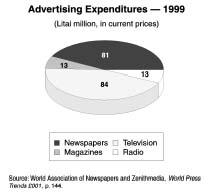
Economic Framework
Overview
Lithuania has few natural resources and was primarily an agricultural country prior to 1940. During the period of Soviet domination, 1940 to 1990, a large but inefficient industrial sector was established. After independence in the 1990s, Lithuania began a comprehensive economic reform toward a market-driven economy, including price reforms, privatization of enterprises, and encouragement of foreign investments. However, 50 years of Soviet occupation had had a devastating economic impact on the country and it was slow to rebound. There was high unemployment, estimated at 10.8 percent, coupled with a slow rate at which new jobs were created. The cost of living increased but salaries and pensions were not commensurate with the escalation. People had trouble maintaining even a minimal standard of living. Lithuania saw a growth in soup kitchens and charitable organizations. Lithuanians spent about 50 percent of their income on utilities and the rest for rent and other necessities. Crime increased and was increasingly emphasized in the press throughout the 1990s.
Advertising
An important factor that has a direct financial effect on the status of the media is advertising or the lack of it. This aspect of the economic system remained undeveloped at the end of the twentieth century. The total advertising expenditure was estimated at 0.2 percent of gross domestic product (GDP). The print media accounted for 50 percent of this expenditure with the daily Lietuvos Rytas , the dominant newspaper. Television accounted for 30 percent of the expenditure, radio 10 percent, and outdoor media the remainder. Western brand goods dominated television airtime, but local advertisers expanded their presence and hoped to steadily increase their presence.
Press Laws
The Lithuanian Constitution, adopted on October 25, 1992, guarantees the freedom of speech, information, and the press as stated in the following articles. Chapter 1 Article 25 specifically states:
- Individuals shall have the right to have their own convictions and freely express them.
- Individuals must not be hindered from seeking, obtaining, or disseminating information or ideas.
- Freedom to express convictions, as well as to obtain and disseminate information, may not be restricted in any way other than established by law. when it is necessary for the safeguard of the health, honor and dignity, private life, or morals of a person, or for the protection of constitutional order.
- Freedom to express convictions or impart information shall be incompatible with criminal actions—the instigation of national, racial, religious, or social hatred, or violence, or discrimination of slander, or misinformation.
- Citizens shall have the right to obtain any available information which concerns them from State agencies in the manner established by law.
Article 44 states:
- Censorship of mass media shall be prohibited.
- The State, political parties, political and public organizations, and other institutions or persons may not monopolize means of mass media.
Censorship
Censorship was enforced during the fifty years of Soviet occupation but the press in Lithuania, since independence, has been heralded as among the most free in the former Soviet states. The constitution provides for free speech and a free press and is essentially free from any overt governmental influence. However, the same article that guarantees this freedom also states that it can be limited if it is necessary to protect the "health, honor and dignity, private life, or morals of a person, or for the protection of constitutional order."
There is another apparent contradiction between the Lithuanian legal code and the Constitution. Article 33 of the Constitution states that "Each citizen shall be guaranteed the right to criticize the work of State Institutions and their officers, and to appeal their decisions. It shall be prohibited to persecute people for criticism." Yet, the Penal Code provides for punishment of up to six months imprisonment or a fine for a public insult, in print or other means of dissemination of information, of a State officer in connection with the duties fulfilled by this person. Precedence was established for this law in 1998 with case against the publishers of Europa . In addition to these constitutional discrepancies intimidation by organized crime groups resulted in increased fear among journalists and even incidents of murder.
State-Press Relations
The press is no longer subsidized as it was under the Soviet occupation, and most newspapers and distributors are privately owned. However, because of the serious problems that faced the nation after independence, the relationship between the media and the government was not always friendly. The newspapers staged a strike in 1991 when the government decided to confiscate media property formerly owned by the Communists. In addition, the government banned foreign investments.
In 1997, Lithuania was the only country in the Baltic region that was self-regulating. It had no state commission for press control. Also at the end of the 1990s, the Lithuanian Parliament amended the law on the media and removed the ceiling for compensation for libel and slander. This change caused journalists to fear an increase in unwarranted and frivolous lawsuits and limitations in their press freedoms. On November 22, 2001, the Lithuanian parliament passed a bill that placed a nine percent value-added tax on mass media.
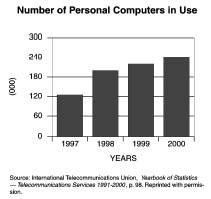
Attitude toward Foreign Press
Lithuanian reporters criticized the western media for using what they considered to be a double standard. The incident that provoked this outcry involved the kidnapping and murder of a photographer from Itar-Tass in 1999 and the failure of the western press to consider the event newsworthy. The arrest, at the same time, of Andrei Babitsky of Radio Liberty was given extensive coverage by the western press.
News Agencies
There are two News Agencies in Lithuania: Lithuanian News Agency (ELTA) which is available online in Lithuanian and English, and the Baltic News Agency (BNS). The BNS is the largest and only news agency that covers all the Baltic States. It employs 140 people and provides news six to seven hundred times per day in five different languages. It has its headquarters in Tallinn, Estonia, but has larger regional office in Vilnius, Lithuania, and Riga, Latvia.
Broadcast Media
The state owns part of the National Radio and Television public broadcasting company but the majority of the mass media is privately owned. The top television station is LNK, whereas the national broadcasting station ranks fourth and last. However, the national radio broadcasting station ranks at the top for listeners. There are approximately 1.9 million radios in Lithuania with three AM stations and one hundred and twelve FM. There are twenty television broadcast stations with thirty repeaters and 1.7 million televisions. The leading private media are financially viable, but the National Radio and Television
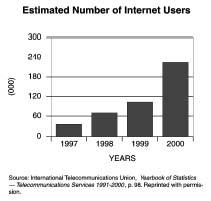
Electronic News Media
In 1996, there were more than 240,000 personal computers, and in 1998 there were 24 Internet hosts per 1,000 population in Lithuania. In 2000, Internet users rose to 225,000; in 2001 there were approximately 25 Internet Service Providers (ISPs). In 2001 an estimated 2 percent of the population was connected to the Internet. There are no restrictions or regulations on the use of the Internet and the law affecting the market, the one granting Lithuanian Telecom a monopoly, expires in 2003.
Education & TRAINING
The press in Lithuania, similar to the other Baltic States, is probably among the world's youngest. News-room and magazine offices find eager but miscast persons in their twenties. Those few journalists who worked during the Soviet period when all publications were owned by the state and controlled by the Communist Party have not been asked to continue with news agencies, leaving few experienced and qualified journalists. Education and training remains a high priority for upgrading and improving the media.
Summary
The press in Lithuania has emerged from its censorship under Soviet domination and has expanded and made many improvements. Nonetheless, at the beginning of the twenty-first century it was encountering problems that detracted from its competency. By contrast to the Latvian and Estonian press, there is an increasing sensationalism in the news that mars the Lithuanian media and journalists continue their role of scandal-hunters. In 2001 scholars and intellectuals complained publicly and wrote to the president about the ten-year decline of moral principles that was widespread in the media. This trend was especially disturbing since the news media ranks among the most trusted institutions, despite its generally low level of talented journalists. In 2001 the media in Lithuania had a 70 percent public confidence rating, the highest of all institutions.
As of 2002, the majority of mass media was privately owned and the leading private media were financially stable. The newspaper distribution system was privately owned, and the media were editorially independent. A number of the privately owned newspapers and some of the independent television stations were editorially diverse. These were progressive steps. However, there were signs that also threatened to limit the freedom of the media and were causing great concern among journalists. Assessing both the positive and negative aspects of the media in Lithuania may extend through the first decade of the twenty-first century during which time the Lithuanian media may well establish a strong new journalistic tradition.
Significant Dates
- 1997: A Conference for East European journalists held in Vilnius concluded that the Lithuanian media is freer than elsewhere in the former Soviet Union.
- 1998: The Swedish media concern, Marieberg, acquired the majority shareholding in the independent LNK television in September. They purchased a forty-four percent shareholding. On April 13, 1998, for the first time in Lithuanian media history, the publishers of the newspaper, Europa, were sentenced for defamation and insult.
- 1999: Polls in Lithuania indicated that the public's trust in the media was at 60 percent whereas their trust in the parliament was only 20 percent.
- 2000: In January, the state-run Lithuanian Radio and Television (LRTV) suspended broadcasts from Radio 2 (culture and education) and Radio 3 (classical and jazz) because of funding problems. On July 27, 2000, President Valdas Adamkus vetoed a new Law on Mass Media that proposed the establishment of a Mass Media Controller financed by the state budget. Journalists were opposed to the idea. In December, the pan-Baltic IT company Tilde Group launched Internet TV portals in all three Baltic States with the Lithuanian TV considered the best.
- 2001: Reuters announced that it would reduce its coverage of the Baltic States in April 2002 because of decreasing interest in the area. Finnish business daily Kauppalehti bought Baltic News Service (BNS).
Bibliography
Adamkus, Valdus. "Lithuania: Negative Media Trends Critiqued." In IPR Strategic Business Information Database (May 29, 2001).
Fenton, Tom. "Mafia targets journalists abroad." Editor & Publisher vol. 127, no. 27 (July 2, 1994): 15-16.
Girnius, Saulus. "The Economies of the Baltic States in 1993." RFE/RL Research Report vol. 3, no. 20 (20 May 1994): 1-14.
—— "Lithuania." RFE/RL Research Report vol. 1, no. 39 (2 October 1992): 70-74.
Hickey, Neil. "A Young Press Corps." Columbia Journalism Review 38 (May 1999): 18.
Jarvis, Howard. "Lithuania." World Press Review, 1997-2001 . Available from http://www.freemedia.at/wpfr/ .
Lieven, Anatol. The Baltic Revolution Estonia, Latvia, Lithuania and the Path to Independence . New Haven: Yale University Press, 1999.
"Lithuania," Europa World Year Book 2001 , 42nd ed., vol. 2, 2504-22.
"Lithuania Online News." News On-Line, 17 April 2002. Available from http://www.only/news.htm .
Navazelskis, Ina. "Lithuania: a killing and a crusade." Columbia Journalism Review vol. 34, no. 2 (July-August 1995): 13-14.
Nichols, Ana. "Channel hopping: the advertising landscape in Lithuania is confused and fast changing. But Western interest in growing." Business Eastern Europe vol. 24, no. 39 (25 September 1995): 4.
RFE/RL Research Institute Staff. "The Media in the Countries of the Former Soviet Union." RFE/RL Research Report vol. 2, no. 27 (2 July 1993): 1-15.
Rose, Richard, and William Maley. "Conflict or Compromise in the Baltic States?" RFE/RL Research Report vol. 3, no. 28 (15 July 1994): 26-35.
Jean Boris Wynn
Do needful and oblige me.
Regds
Ramesh Baid
My mobile no +919833860082